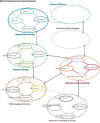|
|
the-south-asian.com July / August 2006 |
|
|||
|
August/September Contents
Sufis - wisdom against 50
years of mountain Heritage cities:
Cotton - the fibre of
|
|
||||
|
Business to Business [ B2B ] Efficiency
& Profits By
First
published January 2001
"Because B2B is bigger than one company it is forcing collaborations among the industry solution providers." A very strong nascent wave of doing business is emerging with the advent of the Internet and the World Wide Web [WWW] architecture. A very simple way of understanding this architecture is to look at how the different evolving Electronic Communities such as Banking, Shipping, and the various vertical industry sectors, will interact with each other. The compelling & driving force behind this new way of doing business [hyper - capitalism] is the efficiencies and cost savings it entails for all business companies. In our previous article we gave an initial flavor of the sort of cost savings to be gained from simply looking at one section of this new way of doing transactions - namely electronic procurement. In this article various aspects of the Business - to - Business [B2B] Commerce are presented. Efficiency & Profits 1 - real-time Accounting [ERP] - the SAP or Banking Model. & Supply Chain Management Initially, just before the Y2K [or the Millennium date problem] period [1999 up to 2000], industry geared itself up by embracing Enterprise Resource Planning [ERP] or real-time accounting. This was the reason behind the tremendous earnings of companies such as SAP or BAAN or Peoplesoft. This was the initial speed - up of business and financial management. Of course the Financial & Banking sector has always been in the forefront of real time accounting systems especially as their business entails the management of liquidity [Cash & Treasury management] and Asset/ Liability management. A loan being shown as an Asset on the Bank’s accounting MIS reports can become a Liability the moment interest payments lag for a certain period. Hence the pressure on Financial Controllers / Treasurers to move towards real-time accounting similar to the Banks. Once the run up to the conversion of accounting systems to Real time accounting was completed and with it the problem of the Y2K bug resolved, companies such as SAP, BAAN Peoplesoft [& even JDEdwards] lost much of their market stock price. A parallel movement that was going on at the same time was the effort to optimize & introduce efficiencies in the area of supply - chain management. Companies in manufacturing were always saddled with excess inventory costs in the process of meeting consumer demand. Just -in-time inventory techniques compelled companies such as Dell Computers to be in business with just 5 days of inventory. As soon as customers placed orders, Dell built the Computers for them. Cash Flow was optimized and profit margins maximized. Supply Chain Management software companies such as I2 [ ITWO NASDAQ ticker symbol, and started by an Indian Sanjiv Sidhu ] and Manugistics [ MANU ]profited and their stock prices jumped higher during 1999 .
As the Internet and the Worldwide web started to grow exponentially [Internet traffic doubles every 100 days according to the UUnet ISP, which belongs to MCI Worldcom and has its hub in Herndon, Virginia, U.S.A.] Communities such as Geocities [later bought by Yahoo for its huge customer base], Hotmail [ co-founder Sabeer Bhatia and later bought by Microsoft for $ 400 million for its 2 million Email customers ] , content aggregator " Infospace [ founder Naveen Jain ] began to grow exponentially . Content grew to serve these communities, in terms of weather, Entertainment, maps & directions to the extent that the Internet Web Pages became an area to be managed by special software. Companies such as " Documentum " & "Interwoven", Web Methods, Broadvision have grown to solve this problem of Content Management especially for the Media Companies and the Catalogs of manufacturing companies. As Electronic Commerce grew with the introduction of Amazon, companies realized that simply putting an E-commerce site meant that 70 % of your customers simply went away without buying anything from the Web Site E-Commerce Portal. The next step was the establishment of another discipline - that of Customer Relationship Management. Gone were the days when a single advertising broadcast jingle was the main method of advertising. Now with the web site statistics of customer telephone number, a customer’s browsing habits, his Credit card statistics, the focusing on advertising to an individual customer became the new wave of marketing. It was necessary to cater to and create Internet based " sticky sites " and communities with niche common interests and then to sell to them products that would fall in their area of life style and interests. Seibel was the major Customer Relationship Management Company, Calico software followed in this respect.
Efficiency & Profits 3 – Internet based Supply/Procurement, Bill Settlement, Trading Exchanges - Big Business / Industry Sectors Start E-Procurement. E-Billing & B2B. The spectacular business growth of Cisco and Dell, based on the Internet sites e-commerce, led to the development of Electronic Procurement. In Banking, especially in the Corporate sector, the area of credit and loans [ ECredit founded by 2 Indians] found Internet a very suitable match by automating the credit analysis of companies through industry specialists such as Standard & Poor , Morningstar ratings and Financial Ratios . The analysis is being complemented by matching a particular customer loan with the appropriate risk taking finance / bank. Traditional Banks, already a very highly saturated industry, find the Internet exerting more pressure to adopt this new technology in the context of becoming efficient. The Customer once again becomes the beneficiary in this area, and the Internet Brokerages [E-Trade, Charles Schwab, and DLJ ] have forced the democratization of the heavy commission brokers such as Merrill Lynch. Electronic Bill payment and settlement is now being extensively embraced by Fortune 500 companies; software companies such as "Bottom Line", "CheckFree" are offering clients such as Fidelity Investments, Merrill Lynch, Wells Fargo, Aetna , Johnson & Johnson, Hertz, Proctor & Gamble electronic payment systems. In Europe about 30 % of the Internet connected users are spending about half an hour [Danes] to an hour and a half [Germans] on the financial sites. In India a new site "www.banknetindia.com" is advertising itself as a one-stop portal for Indians and NRI’s. Vertical [ Chemdex became Ventro, Plastics.net, PharmaNet, Worldoffruit.com, Petroleum exchange PEPEX, SciQuest , Paperexchange , AltraEnergy] industry Exchanges have started off and so too have Bid/Auction exchanges for used machinery . Using XML to pass the Data from one Data Base to another, companies such as Web Methods have been able to accomplish the same kind of real time efficiency which was previously found in a Bank’s environment. The traditional end-of-day account Reconciliation which took place between a bank’s branches so that all credit and debit transaction details were matched for transactions from one branch to another branch, such account reconciliation was now extended to the transactions taking place between companies engaged in B2B transactions. Thus the accounting systems of companies buying computers from Dell or Office Supplies from Staples were getting their accounting systems updated in real time very similar to a Banks internal branch settlement or Reconciliation systems. This naturally meant a tremendous increase in the velocity of money flowing between companies and the end of day "Float" now available to Treasurers or Financial Controllers of companies in B2B commerce is much more rapidly available for immediate use. This electronic updating of accounts while traditionally pioneered by the Banking and Financial sectors in the form of S.W.I.F.T. [Society for the Worldwide Interchange of Financial Transactions] And other automated Clearing Houses for Credit Card Payments, is now being extended to the rest of the Business world globally. B2B
Internet-based Communities/Exchanges
Problems & Industry Standards The need for collaboration in the definition of industry standards is borne out by the creation of bodies such as "RosettNet" which is a consortium of 350 Electronic Component, Information Technology and Semiconductor companies [self-funded, and non-profit] set up to define standards in the emerging B2B areas. Another institution that was created by a grant from the National Institute of Standards [ NIST] was "Bizbots". The mandate here was to design and deploy next generation standards for electronic commerce. The result was an advanced digital exchange engine, with 100% Java agent – enabled marketplace that allows companies to create powerful, real-time, dynamic, multi-buyer/multi-seller digital exchanges. The Bizbots e-commerce solution is massively scalable, fault-tolerant, supporting advanced features such as multiple trading qualities, aggregation, haggling, risk determination, reputation management, real-time access to trading history and transaction fulfillment. Similarly XML standards are being built by different industry sectors to define the format of their transaction data. Because B2B is bigger than one company it is forcing collaboration among the industry solution providers. "Ariba" efforts to create 10 Vertical exchanges in Japan with the Japanese company " SoftBank" after its success with Cisco, Fedex and Chevron are indicative of the complexity of this area. *****
|
|||||
|
Copyright © 2000 - 2006 [the-south-asian.com]. Intellectual Property. All rights reserved. |
|||||

